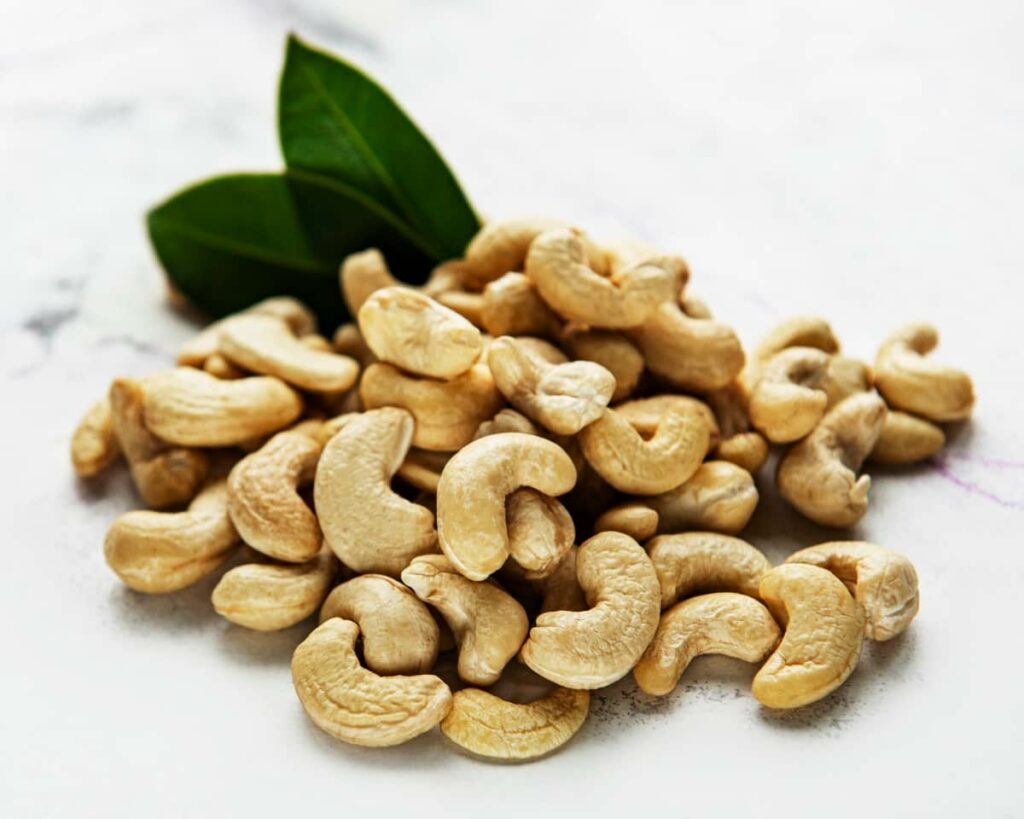Blog
The Journey of Cashews from Orchard to Oven?

1. The Origin: Cashew Trees and Orchards
The journey of cashews begins in tropical regions, primarily in countries such as Brazil, Vietnam, India, and West Africa. Cashew trees (Anacardium occidentale) thrive in these warm and humid climates. These trees bear cashew apples, which have a juicy pulp but are not the part we commonly consume. The cashew nut itself grows attached to the bottom of the cashew apple, encased in a protective shell.
2. Harvesting Cashew Apples
The harvesting process typically begins between January and May when the cashew apples ripen. Harvesters carefully pick the cashew apples by hand, ensuring they don’t damage the attached cashew nuts. It’s a labor-intensive process that often involves climbing the tall cashew trees.
3. Extracting the Cashew Nuts
After harvesting, the cashew apples are transported to processing facilities. Here, the cashew nuts are extracted from their shells. This involves several steps:
- Drying: The cashew apples are left to dry in the sun or in drying machines. This reduces the moisture content and makes it easier to separate the nuts from the apples.
- Shelling: Once dried, the cashew apples are mechanically shelled to reveal the cashew nut within.
4. The Nut Inside the Shell
Inside the shell, the cashew nut is nestled within a protective layer called the cashew shell. It’s crucial to note that this shell contains a caustic oil known as urushiol, which can cause skin irritation and should be handled with care.
5. Removing the Shell
To make cashews safe for consumption, the cashew shells must be removed. This is done through a careful roasting process. The nuts are roasted at high temperatures to ensure the shell becomes brittle and can be easily cracked open. After roasting, the cashews undergo a mechanical shelling process to remove the shell.
6. Sorting and Grading
Once the shells are removed, the cashews are sorted and graded based on size and quality. Larger, whole cashews are often preferred for premium products, while smaller pieces and broken cashews are used in various culinary applications.
7. Roasting: The Final Transformation
After sorting and grading, it’s time for the most crucial step—roasting. Roasting enhances the flavor and texture of cashews. It’s during this process that the cashews take on that irresistible crunch and develop their rich, nutty flavor.
- Oven Roasting: The cashews are spread in a single layer on large trays and placed in ovens. The ovens roast the nuts evenly, turning them a beautiful golden-brown color.
- Cooling: Once roasted to perfection, the cashews are cooled to room temperature before packaging. This allows them to maintain their crispness.
8. Packaging and Distribution
After roasting and cooling, the cashews are packaged in airtight containers to preserve their freshness and prevent moisture from compromising their quality. These packages are then distributed to stores, markets, and consumers worldwide, where they are enjoyed as a nutritious snack or used in a wide range of culinary creations.
The journey of cashews from orchard to oven is a fascinating and labor-intensive process that transforms these humble nuts into the irresistible snacks we adore. From the tropical orchards where they are grown and handpicked to the careful extraction of the nuts from their shells and the meticulous roasting process, each step plays a vital role in delivering the perfect cashew to your oven. So, the next time you savor a handful of these delectable nuts, you can appreciate the incredible journey they’ve taken to reach your taste buds.
9. Sustainable Practices
As the demand for cashews continues to grow, there’s an increasing emphasis on sustainable and ethical practices in the cashew industry. Many cashew producers are adopting environmentally friendly farming methods, fair labor practices, and responsible sourcing to ensure the long-term viability of cashew cultivation.
10. Global Trade
Cashews are a globally traded commodity, and the journey from orchard to oven often involves international trade and distribution networks. These networks connect cashew-producing regions with markets and consumers worldwide, making cashews one of the most traded tree nuts globally.
11. Culinary Applications
Cashews are not only enjoyed as a roasted snack but are also widely used in various culinary applications. They can be ground into cashew butter, used in both savory and sweet dishes, and even transformed into dairy-free milk alternatives like cashew milk.
12. Nutritional Benefits
Throughout their journey, cashews retain their nutritional value. They are a good source of healthy fats, protein, dietary fiber, vitamins, and minerals. Cashews are known for their heart-healthy monounsaturated fats and their role in promoting overall well-being.
13. Economic Impact
Cashew cultivation and processing have a significant economic impact on many countries, providing employment opportunities for millions of people. The cashew industry plays a crucial role in supporting livelihoods and economic development in cashew-producing regions.
The journey of cashews from orchard to oven is a complex and fascinating process that involves multiple steps, from harvesting the cashew apples to roasting the nuts to perfection. Along the way, cashews undergo various transformations, both in terms of physical appearance and flavor. This journey is a testament to the dedication of farmers, harvesters, and processors who work tirelessly to bring these delectable nuts to consumers around the world.
So, the next time you enjoy a handful of roasted cashews, take a moment to appreciate the incredible journey they’ve undertaken, spanning continents and involving countless hands, to become the irresistible and nutritious snack that brings joy to your palate.
Outline of the Article:
I. Introduction
- Importance of cashews in culinary delights
- Brief overview of the journey from orchard to oven
II. The Cultivation Process
- Cashew tree cultivation and growth stages
- Harvesting techniques for ripe cashew nuts
III. Processing and Shelling
- Traditional methods vs. modern processing techniques
- Challenges faced in shelling cashew nuts
IV. The Journey to the Oven
- Sorting and cleaning of raw cashews
- Different methods of roasting cashews
V. Roasting Techniques
- Dry roasting vs. oil roasting: a comparison
- Importance of temperature and duration in roasting
VI. Flavor Infusion and Seasoning
- Adding flavors during the roasting process
- Popular seasoning options for roasted cashews
VII. Packaging and Distribution
- Packaging techniques to preserve freshness
- Distribution channels and worldwide demand
VIII. Health Benefits of Cashews
- Nutritional value and health advantages
- Incorporating cashews into a balanced diet
IX. Sustainability and Ethical Considerations
- Sustainable farming practices in the cashew industry
- Ethical considerations for conscious consumers
X. The Culinary Delights
- Creative ways to use roasted cashews in cooking
- Recipes and dishes enhanced by roasted cashews
XI. Conclusion
- Recap of the cashew journey from orchard to oven
- Appreciation for the versatile and flavorful cashew nut
Article: The Journey of Cashews from Orchard to Oven
Introduction
Cashews, those delectable kidney-shaped nuts, have a special place in the hearts of food enthusiasts worldwide. Their journey from orchard to oven is nothing short of fascinating, involving careful cultivation, intricate processing, and a touch of culinary magic. In this article, we’ll explore the captivating odyssey of cashews, tracing their path from the lush orchards to the ovens where they transform into the crispy delights we all love.
The Cultivation Process
Cashews start their journey as seeds within the tropical cashew tree’s vibrant, sprawling orchards. These trees, native to coastal regions, require specific conditions to thrive, including warm temperatures and well-drained soil. The cultivation process involves nurturing the trees through various growth stages, ensuring they receive the right balance of sunlight and water. Harvesting cashew nuts requires a delicate touch, as they are encased in a shell within a fleshy cashew apple.
Processing and Shelling
Once harvested, cashew nuts undergo a series of processes to transform them from raw seeds to edible delights. Traditional methods involve hand-shelling, a labor-intensive task that requires skill and precision. In modern processing facilities, innovative techniques are employed to streamline the shelling process, making it more efficient and less labor-intensive.
The Journey to the Oven
After shelling, raw cashews are sorted, cleaned, and prepared for their transformative journey to the oven. The journey begins with the careful selection of high-quality nuts, ensuring they meet the standards of freshness and quality. Different methods of roasting come into play, each contributing to the unique flavor profile of the final product.
Roasting Techniques
Roasting, a critical step in the cashew journey, involves two primary techniques: dry roasting and oil roasting. Dry roasting utilizes the natural oils present in the cashews, while oil roasting enhances the flavor and texture. The temperature and duration of roasting are meticulously controlled to achieve the perfect balance of crunchiness and flavor.
Flavor Infusion and Seasoning
During the roasting process, cashews have the opportunity to absorb delightful flavors. Various seasonings, ranging from classic salt to exotic spices, are infused, adding layers of taste and aroma. This infusion process elevates the cashew’s natural flavor, making them a versatile ingredient in a wide array of culinary delights.
Packaging and Distribution
Once roasted and seasoned to perfection, cashews are carefully packaged to preserve their freshness. Proper packaging techniques, including vacuum sealing and airtight containers, ensure that the cashews maintain their crunchiness and flavor. From there, they embark on a global journey, reaching the shelves of grocery stores and the kitchens of culinary enthusiasts worldwide.
Health Benefits of Cashews
Beyond their delightful taste, cashews offer a plethora of health benefits. They are rich in healthy fats, proteins, vitamins, and minerals. Consuming cashews in moderation can support heart health, aid in digestion, and provide a quick energy boost. Their nutritional value makes them a popular choice among health-conscious individuals.
Sustainability and Ethical Considerations
In recent years, the cashew industry has seen a growing focus on sustainability and ethical practices. Responsible farming techniques, fair trade initiatives, and environmentally friendly practices are becoming integral parts of the cashew journey. Conscious consumers play a crucial role in supporting these initiatives by choosing ethically sourced cashew products.
The Culinary Delights
Roasted cashews, with their irresistible crunch and rich flavor, find their way into a myriad of culinary creations. From savory dishes like curries and salads to sweet delights like desserts and chocolates, roasted cashews add depth and texture to a wide range of recipes. Their versatility knows no bounds, making them a favorite ingredient among chefs and home cooks alike.
Conclusion
The journey of cashews from orchard to oven is a testament to human ingenuity and nature’s bounty. From the careful cultivation of cashew trees to the intricate processes of shelling and roasting, each step contributes to the creation of these delectable nuts. As consumers, appreciating the craftsmanship and dedication involved in bringing roasted cashews to our tables enhances the culinary experience. So, the next time you savor the irresistible crunch of a roasted cashew, remember the fascinating journey it undertook to reach your palate.
FAQs About Cashews:
Q1: Are roasted cashews healthier than raw cashews? A1: Roasting cashews does not significantly alter their nutritional content. However, roasted cashews may be easier to digest due to the breakdown of certain compounds during the roasting process.
Q2: Can I roast cashews at home without an oven? A2: Yes, you can roast cashews on a stovetop using a pan. Heat the pan, add cashews, and stir frequently until they turn golden brown. Be vigilant to prevent burning.
Q3: What is the ideal temperature for roasting cashews? A3: The ideal roasting temperature for cashews is around 350°F (175°C). However, it’s essential to monitor the roasting process closely to avoid over-roasting.
Q4: Can roasted cashews be used in vegan and vegetarian recipes? A4: Absolutely! Roasted cashews add a creamy texture and nutty flavor to various vegan and vegetarian dishes, making them a popular ingredient in plant-based cooking.
Q5: How should I store roasted cashews to maintain their freshness? A5: Store roasted cashews in an airtight container in a cool, dry place. For extended freshness, consider refrigerating or freezing them, especially if you’ve roasted a large batch.



